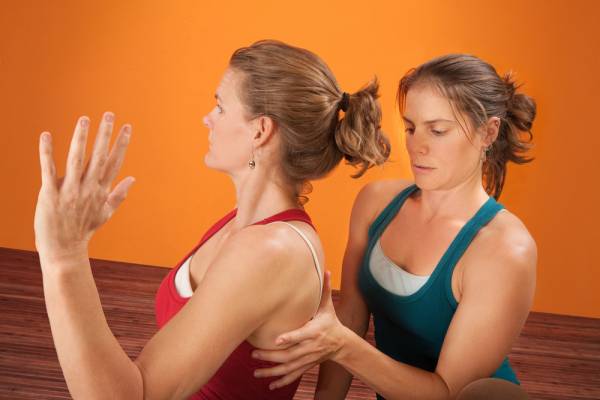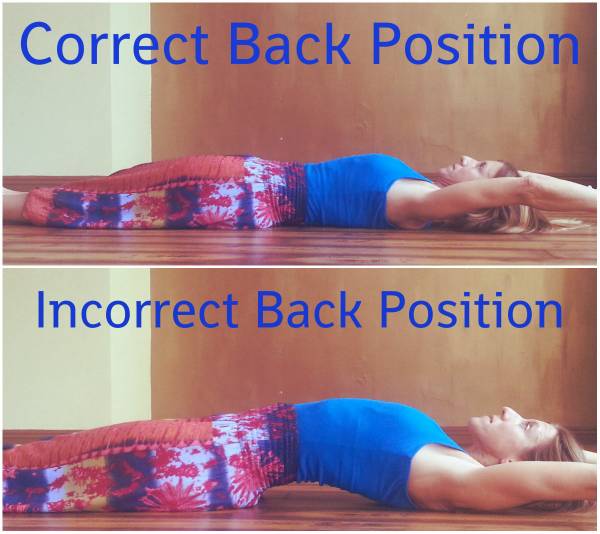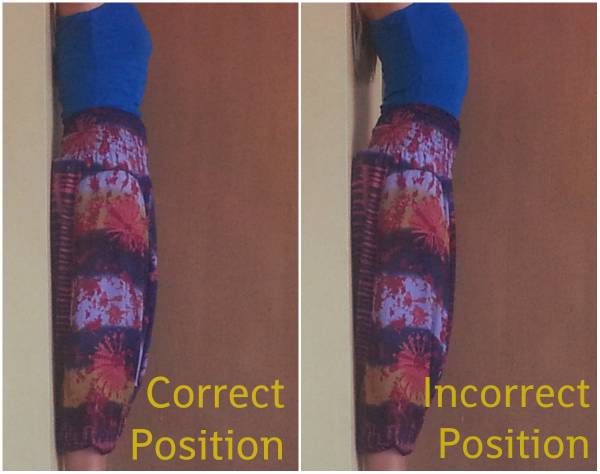I came to yoga with years of unconscious holding patterns in my shoulders and neck. Over time these patterns began to yield and were replaced with more intelligent habits. Yet I still found myself going through periods of acute and chronic shoulder and neck pain – even migraine headaches.
When I became a yoga teacher, this situation became perplexing and kind of embarrassing, to be honest. How could I be helping others find freedom in their bodies and still be experiencing this pain in mine?
Poor posture can lead to chronic neck and shoulder pain, even if you practice yoga frequently.
This question prompted my personal inquiry into new ways of practicing. What I discovered is that I had adjusted my posture from the outside so it looked better, but there was still much inner work to be done.
There are a few specific things that contributed to my freedom from the pain I was experiencing. I’m going to share these simple (though not easy) insights in the hopes that others will find liberation, too.
Common Cues
The body conforms to what we do most. The activities of modern life have us sitting in front of steering wheels and computers, as well as bowing before other handheld gadgets for countless hours every day. These actions promote poor posture, especially in the thoracic and cervical spine. This poor posture leads to pain in those and other areas and even headaches.
“The spine is designed to help us stay upright and move through gravity with the least amount of effort and impact on our bodies.”
A few of the main alignment cues I was taught in yoga teacher training and hear perpetuated in classes are: draw your shoulder blades together, draw your shoulder blades down, and widen your collarbones. Some teachers go so far as to say, “Pretend you’re squeezing a pencil between your shoulder blades.” Yikes!
Taken out of context, following these instructions can interfere with the spine’s natural curves, which are designed to bear weight and keep the body tension free. To understand this let’s look at how the spine is shaped. The four distinct sections of the spine are:
- Cervical (or neck) – curves in
- Thoracic (upper/middle back) – curves out
- Lumbar (lower back) – curves in
- Sacrococcygeal (sacrum/pelvis) – curves out
The spine is designed to help us stay upright and move through gravity with the least amount of effort and impact on our bodies. Because the dominant pull of gravity is downward, good posture involves lengthening upward through the spine. In addition, attaining and maintaining a healthy spine involves carrying ourselves in a way that does not detract too from the natural curves of the spine.
Because the thoracic spine curves out, instructions like “shoulder blades together and down your back” tend to force the front ribs out and the thoracic spine in. This creates compression in the upper and middle back and interferes with the ability to lengthen the spine up. Most yoga practitioners and others have the misconception that moving the rib cage forward lengthens the spine. There can be no comprehension of how to actually lengthen the upper middle back areas as long as forward is being mistaken for up.
“Because the thoracic spine curves out, instructions like ‘shoulder blades together and down your back’ tend to force the front ribs out and the thoracic spine in.”
Furthermore, this creates a lot of tension in the thoracic spine and causes the lower back to over mobilize (remember, it’s all connected). And the tight muscles in the thoracic spine restrict circulation in the body. Considering that the upper and middle back house the heart and lungs, the value of this awareness goes beyond aesthetics or getting rid of shoulder pain. The ability to allow space in that area is vital for our overall health and well-being.

Some teachers go so far as to say, “Pretend you’re squeezing a pencil between your shoulder blades.” Yikes!
Effects on the Head
Pushing the thoracic spine in and down also often causes the head to move forward, putting extra pressure on the cervical spine. The average head weighs five to eleven pounds. The cervical vertebrae are small and are not meant to carry a lot of weight. The head, therefore, is meant to bobble. I actually use the image of a bobble-head doll to help students find the proper way to carry their heads.
“The jaw, neck, and throat tend to be the first place tension appears in response to any stress trigger, such as fear, anxiety, annoyance, worry, hurry, etc.”
Jutting the chin too far forward also puts the neck out of alignment. This can happen even if the upper and middle back are in good form. The jaw, neck, and throat tend to be the first place tension appears in response to any stress trigger, such as fear, anxiety, annoyance, worry, hurry, etc. So it’s important to do regular check-ins throughout the day to bring this area back into alignment.
Create New Habits
So how do we find more resourceful ways to inhabit our bodies in relation to these patterns? I’m going to share a few simple things you can start doing today. Keep in mind these actions may not be easy, especially at first. In undoing well-worn patterns, it takes repeated correction to create a new habit. So we must be consistent and persistent, but it’s worth it – I promise!
1. Bring the front ribs down and back and lift the back ribs up.
It may feel like you’re rounding your back, but you won’t be unless you overdo it. You will simultaneously feel your lower back and tailbone area lengthen downward. This is counterintuitive for most of us. It is even difficult for many long-time yoga practitioners. To explore this:
- Lie on your back on a firm surface like the floor.
- Stretch your arms over your head and feel which areas of your back are touching the floor. Chances are your middle back is arching away from the floor.
- Now bring your bottom front ribs down and your navel up. Feel how that allows your middle back to connect more fully with the floor. You’ll notice if you take this action too far your upper back will begin to round so stop before that happens.
- Once you’ve found this on the floor try it in a seated and then standing position.

2. Widen the shoulder blades.
In yoga terms, the idea of opening the chest is often communicated as “widen the collarbones.” To accomplish this, most of us squeeze the shoulder blades together. Instead, what I find helpful is to start with the shoulder blades and imagine them widening apart rather than moving together. As I do this, the chest may begin to round. It’s at that point that I start to widen the chest. These two actions done simultaneously create a balanced sense of space in the chest and upper back.
3. Chin down, ears back.
Think bobble-head doll. How to do this:
- Stand with your back against a wall.
- Find the actions we established above in the thoracic spine and feel the effect those have on your neck and head.
- Bring the chin down slightly and imagine the ears moving back in space.
- Begin to climb the back of your head up the wall. This is a subtle movement and the range of motion will be small. The important thing is that you feel a lengthening up through the back of the neck (cervical spine).
4. Breathe slower, deeper, longer breaths.
Once you’ve established the alignment in your whole spine per the exercises above, you can bring your breath into the equation. Choose the position in which you feel most supported – either lying on the floor or standing against a wall.
Try inhaling through the nose to a count of three or more. Specifically, feel the inhale in the upper body allowing the front, back, and side ribs to expand. The shoulder blades will also lift away from the back. Exhale through the nose for three counts or more with a focus on drawing the navel back as the spine lengthens and maintaining some of that space you created in the upper back and chest with the inhale.

Practice standing against a wall to bring your spine, including the neck, into alignment while incorporating the breath described above at least once a day for five minutes. You can use what you learn in this practice to bring awareness to your body throughout the day. Notice what’s happening when you’re driving, typing, or texting. Notice how this new awareness alleviates acute and chronic pain in the shoulders and neck, and even a cessation of headaches.
Be Persistent
Remember, if you’re training for a marathon or studying for a big exam, you don’t give up at the first sign of disinterest or resistance. Think of this work too as a disciplined training. You’re learning to experience all the space and freedom available to you within your body. At first this make take a lot of effort and you may encounter resistance, but if you persist, the physical, mental, and emotional benefits will be undeniable.
More Like This:
- 3 Quick and Simple Ways to Relieve Neck Pain and Stiffness
- Downward Dog at the Wall: Releasing Neck Tension
- 5 Simple Exercises to Eliminate Neck Pain
- New on Breaking Muscle Today
Photos 1 and 2 courtesy of Shutterstock.
Photos 3 and 4 courtesy of Alison Bristow-Wilburn.






